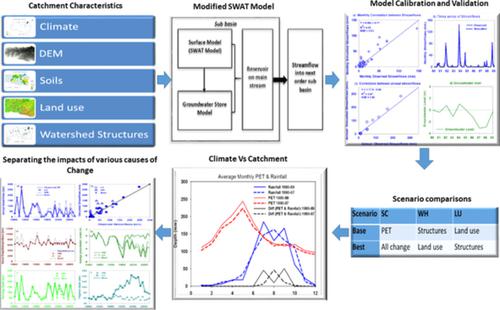当前位置:
X-MOL 学术
›
Hydrol. Process.
›
论文详情
Our official English website, www.x-mol.net, welcomes your
feedback! (Note: you will need to create a separate account there.)
A comprehensive assessment framework for attributing trends in streamflow and groundwater storage to climatic and anthropogenic changes: A case study in the typical semi-arid catchments of southern India
Hydrological Processes ( IF 2.8 ) Pub Date : 2021-07-06 , DOI: 10.1002/hyp.14305 Rajesh Nune 1, 2 , Biju A. George 1 , Andrew W. Western 1 , Kaushal K. Garg 2 , Sreenath Dixit 2 , Ragab Ragab 3
Hydrological Processes ( IF 2.8 ) Pub Date : 2021-07-06 , DOI: 10.1002/hyp.14305 Rajesh Nune 1, 2 , Biju A. George 1 , Andrew W. Western 1 , Kaushal K. Garg 2 , Sreenath Dixit 2 , Ragab Ragab 3
Affiliation

|
The clearest signs of hydrologic change can be observed from the trends in streamflow and groundwater levels in a catchment. During 1980–2007, significant declines in streamflow (−3.03 mm/year) and groundwater levels (−0.22 m/year) were observed in Himayat Sagar (HS) catchment, India. We examined the degree to which hydrologic changes observed in the HS catchment can be attributed to various internal and external drivers of change (climatic and anthropogenic changes). This study used an investigative approach to attribute hydrologic changes. First, it involves to develop a model and test its ability to predict hydrologic trends in a catchment that has undergone significant changes. Second, it examines the relative importance of different causes of change on the hydrologic response. The analysis was carried out using Modified Soil and Water Assessment Tool (SWAT), a semi-distributed rainfall-runoff model coupled with a lumped groundwater model for each sub- catchment. The model results indicated that the decline in potential evapotranspiration (PET) appears to be partially offset by a significant response to changes in rainfall. Measures that enhance recharge, such as watershed hydrological structures, have had limited success in terms of reducing impacts on the catchment-scale water balance. Groundwater storage has declined at a rate of 5 mm/y due to impact of land use changes and this was replaced by a net addition of 2 mm/y by hydrological structures. The impact of land use change on streamflow is an order of magnitude larger than the impact of hydrological structures and about is 2.5 times higher in terms of groundwater impact. Model results indicate that both exogenous and endogenous changes can have large impacts on catchment hydrology and should be considered together. The proposed comprehensive framework and approach demonstrated here is valuable in attributing trends in streamflow and groundwater levels to catchment climatic and anthropogenic changes.
中文翻译:

将溪流和地下水储存趋势归因于气候和人为变化的综合评估框架:印度南部典型半干旱集水区的案例研究
从集水区的溪流和地下水位的趋势可以观察到最明显的水文变化迹象。在 1980-2007 年期间,在印度喜玛雅萨加尔 (HS) 流域观察到流量(-3.03 毫米/年)和地下水位(-0.22 米/年)显着下降。我们检查了在 HS 流域观察到的水文变化在多大程度上可归因于变化的各种内部和外部驱动因素(气候和人为变化)。本研究使用调查方法来归因水文变化。首先,它涉及开发一个模型并测试其预测发生重大变化的流域水文趋势的能力。其次,它检查了不同变化原因对水文响应的相对重要性。使用改良土壤和水评估工具 (SWAT) 进行分析,这是一种半分布式降雨径流模型,结合每个子集水区的集总地下水模型。模型结果表明,潜在蒸散量 (PET) 的下降似乎被对降雨变化的显着响应所部分抵消。加强补给的措施,例如流域水文结构,在减少对流域规模水平衡的影响方面取得的成功有限。由于土地利用变化的影响,地下水储存量以 5 毫米/年的速度下降,并被水文结构净增加 2 毫米/年所取代。土地利用变化对径流的影响比水文结构的影响大一个数量级,约为2。地下水影响高出 5 倍。模型结果表明,外源性和内源性变化都会对流域水文产生巨大影响,应一并考虑。此处展示的拟议综合框架和方法对于将流域和地下水位趋势归因于集水区气候和人为变化很有价值。
更新日期:2021-08-07
中文翻译:

将溪流和地下水储存趋势归因于气候和人为变化的综合评估框架:印度南部典型半干旱集水区的案例研究
从集水区的溪流和地下水位的趋势可以观察到最明显的水文变化迹象。在 1980-2007 年期间,在印度喜玛雅萨加尔 (HS) 流域观察到流量(-3.03 毫米/年)和地下水位(-0.22 米/年)显着下降。我们检查了在 HS 流域观察到的水文变化在多大程度上可归因于变化的各种内部和外部驱动因素(气候和人为变化)。本研究使用调查方法来归因水文变化。首先,它涉及开发一个模型并测试其预测发生重大变化的流域水文趋势的能力。其次,它检查了不同变化原因对水文响应的相对重要性。使用改良土壤和水评估工具 (SWAT) 进行分析,这是一种半分布式降雨径流模型,结合每个子集水区的集总地下水模型。模型结果表明,潜在蒸散量 (PET) 的下降似乎被对降雨变化的显着响应所部分抵消。加强补给的措施,例如流域水文结构,在减少对流域规模水平衡的影响方面取得的成功有限。由于土地利用变化的影响,地下水储存量以 5 毫米/年的速度下降,并被水文结构净增加 2 毫米/年所取代。土地利用变化对径流的影响比水文结构的影响大一个数量级,约为2。地下水影响高出 5 倍。模型结果表明,外源性和内源性变化都会对流域水文产生巨大影响,应一并考虑。此处展示的拟议综合框架和方法对于将流域和地下水位趋势归因于集水区气候和人为变化很有价值。











































 京公网安备 11010802027423号
京公网安备 11010802027423号